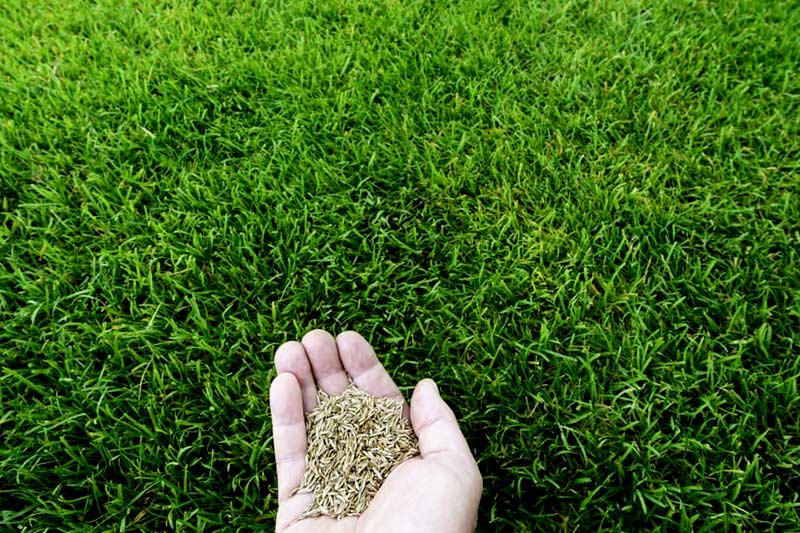In the realm of lawn installation, two popular methods are hydroseeding and traditional seeding. Both approaches have their own set of advantages and disadvantages. However, if you were faced with choosing one over the other, which would be the most suitable choice for you?
Hydroseeding is better than seeding. It gives rise to healthier grass, has a higher success rate, helps to reduce erosion, and has a lower risk of getting washed away. However, seeding is better in terms of affordability and ease of application.
Here is everything you should know about
What are the benefits of hydroseeding?

The following are the reasons why hydroseeding is better than seeding.
Better odds of success
Hydroseed consists of seeds, mulch, and all that the grass needs in order to survive. Everything is optimized and controlled to guarantee success.
As a result, during the early stages of the grass, everything that the seeds need is catered for. This increases their odds of survival. This is unlike what happens with seeding.
With seeding, all you do is place the seeds on the soil. The environment that the seeds encounter is unpredictable. It is not optimized to guarantee success. And as a result, when compared to hydroseeding, seeding offers a lower success rate.
Better quality
Hydroseeding tends to provide higher-quality lawn results than seeding. This is because hydroseed tends to have all the nutrients and moisture that it needs at the onset. And given that it is less likely to be patchy — due to the high germination success rate — it will yield a healthier and better-looking lawn.
With seeding, the likelihood of patchiness is higher since the seeds don’t have the perfect conditions for survival. This, in addition to the fact that the seeds will be largely dependent on varying environmental conditions, usually ends up with a less appealing lawn.
Faster results
With hydroseeding, you will start seeing results faster.
In less than a week, you will start to see results. And as soon as 3 weeks, your lawn can be ready for mowing. This is because the hydroseed slurry is optimized to ensure that the ideal nutrients, mulch, and even seed type are mixed to guarantee a thriving lawn.
With conventional seeding, everything isn’t as optimized. A lot of things are left to chance. This includes nutrient availability and moisture accessibility. As a result, it usually takes longer for such lawns to get established.
Ideal for erosion control
Binding agents and mulch help to create a stronger bonding within the hydroseed mix. And so once it has dried, the hydroseed is harder to wash away even when applied on erosion-prone areas.
With time, the grass will grow and sink its roots deep into the soil, something that will then bind and stabilize the soil. This will then help to reduce the rate of soil erosion in the area.
Requires less water
Once you establish a lawn with hydroseed, you won’t need to water it constantly. This is because the mulch in the hydroseed can absorb moisture up to 10 times its weight. This ensures that the seeds will have a sufficient supply of moisture. Therefore, you won’t have to water the lawn as often.
With traditional seeding, you will have to water the seeds regularly. If you fail to do it, the seeds will fail to germinate. The lawn will also take longer to get established. And so if you want good results, you have to commit to watering it consistently.
Lower risk of getting washed away
Hydroseed slurry contains a binding agent. This agent holds the contents of the slurry together and helps to protect the hydroseed from getting washed away by strong winds and rainfall. This is something that minimizes waste and increases the odds of a perfect installation.
With seeding, the grass seeds are left exposed. They don’t have anything to stick to or to hold on to when heavy rainfall and strong winds come. And so they tend to get washed away.
Therefore, if you opt for seeding, you may find yourself having to reseed your lawn. This makes it a less efficient method of lawn installation.
It is faster
When dealing with large areas, hydroseeding offers a quicker solution. This is mainly because all that the seeds need to grow are applied simultaneously.
It doesn’t involve a multi-step application process. And this simplicity in the application process helps to save time, especially when dealing with larger areas.
It can be cost-effective
When you have to establish a lawn on a large scale, hydroseeding is always recommended. This is because it is faster and less labor-intensive than traditional seeding.
Therefore, if you are planning on establishing a lawn on a large scale, you will find hydroseeding to be way more pocket friendly than other methods of new lawn installation.
Lower risk of weed growth
Hydroseed comes already armed with compounds that are designed to suppress weed growth. As a result, lawns established with hydroseed have a lower risk of having weed problems.
They need less maintenance. They cost less to keep in good shape since you don’t have to worry about weed control costs. And they are generally more attractive since they are less likely to be invaded by weeds.
Traditional seeding methods leave your lawn at the mercy of weeds. Opting to establish your lawn using these methods means that you will always have to worry about weed control.
Are there any disadvantages to hydroseeding?
Yes, as a lawn establishment technique, hydroseeding has a few shortcomings.
Here are the ones that stand out.
It is not as budget-friendly
When compared to hand seeding, hydroseed is a less affordable method of lawn establishment. This is because it often requires the use of skilled labor and machinery that hand seeding doesn’t. And so if you are on a budget, hydroseeding may not be ideal for you.
Not viable in some cases
If you are planning to establish a lawn in a remote area that isn’t easily accessible, opting for hydroseeding may be impractical.
Hydroseeding is only practical for areas that can be easily accessed by a hydroseeder. And so if you don’t have enough space to accommodate a hydroseeder, hydroseeding may be impractical.
It is not DIY friendly
A hydroseeder is expensive. Purchasing it with the aim of using it on your lawn will be financially imprudent. There is also the fact that it takes some skill to operate it perfectly.
Therefore, if you prefer to install and maintain your lawn on your own, hydroseeding is not the best option. If you want your lawn to be hydro seeded, you will have to hire a lawn care company.
What are the benefits of seeding over hydroseeding?
Traditional seeding methods are preferred over hydroseeding in certain circumstances. Here are some of the reasons why you may choose them over hydroseeding.
Budget-friendly
If you are on a budget, then you should opt for seeding as a way of establishing your lawn. This is because it is the most affordable way of doing so.
Viable even for remote areas
Seeding doesn’t require the use of heavy machinery like seeders. This makes it an incredibly versatile method of lawn installation. It is one whose application isn’t restricted by the accessibility or remoteness of an area. Therefore, it is almost always a practical way of establishing a lawn.
DIY-friendly
Seeding is affordable. It also doesn’t require the use of specialized machinery. These two things make it great for DIY projects. And so if you love to do things on your own and at your own pace, seeding is recommended.
What are the disadvantages of seeding?
Seeding isn’t a better option when compared to hydroseeding because of the following reasons.

It is likely to have patches
With seeding, there is a higher likelihood of the seeds failing to germinate. This will leave your lawn with patches. And so you may have to reseed down the road.
It takes more time to get results
With seeding, you may have to wait way longer in order to see any results. This is because the environment that the seeds will land in isn’t perfectly optimized to guarantee a higher success rate.
They won’t have the perfect amount of fertilizers and nutrients. They also won’t have the ideal level of moisture supply. As a result, seeded lawns tend to take longer in order to become fully established.
More watering
Once you spread the seeds on your lawn, you will need to water them on a regular lawn. Failure to do so will lead to germination failure. It will also lead to unhealthy grass. And it may even cause a delay in your lawn getting established.
This is unlike what happens with hydroseeding. Since the mulch in the hydroseed can absorb a lot of water, once you hydroseed your lawn, you don’t have to water it constantly. The moisture in the mulch is often enough to keep it sufficiently moisturized. And so the lawn won’t need as much attention as one that is seeded.
Use this free service to find an expert near you
If you need help maintaining your lawn, use this free service.
HomeGardenGuides.com offers a FREE service that puts you in contact with qualified professionals in your area.
Here is how it works.
- You scroll to the top of the page and enter your Zip code.
- Answer questions about your needs and preferences
- Your details will be forwarded to three local experts.
- You will then receive a price estimate – in writing – for the job and some friendly advice.
IMPORTANT: There is no obligation to hire. This is a free tool and service to be used at your pleasure.

FAQ's
If you need to water your lawn, you can walk on hydroseed after it has dried provided you don’t disturb it. However, this does not mean that the area can withstand the trauma of constant foot traffic. For your grass to be able to survive foot traffic, it will need about 3 weeks after hydroseeding.
Hydroseed takes as little as 5 days to sprout. With proper care, you can start mowing your lawn within a month. This is a fast growth rate that is attractive to most homeowners and makes hydroseeding a go-to choice for people who want faster lawn installation results.
The best time to hydroseed is either fall or spring. These seasons are perfect for hydroseeding because they don’t feature extreme weather. The weather isn’t too cold or too hot. Also, it isn’t too dry or too wet.
No, rain doesn’t typically wash away hydroseed. It can wash away the dye, but the chances are that the seeds will still remain even after rainfall. This is because hydroseed usually has mulch and other binders that help to keep the seeds from being washed away.






